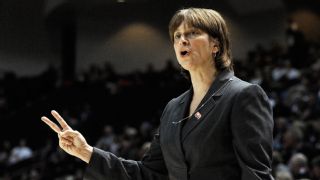|
The first coach I ever interviewed didn't believe in yelling at athletes. He didn't think negativity worked at any volume, in fact, at least not over the long term. He coached college track and field and taught sports psychology, and to my knowledge he always practiced what he preached. This first interview was in 1984; I was a freshman in college just learning how to be a reporter. In the 32 years since, I've covered hundreds of coaches in multiple sports who've run the gamut on the "screamer meter," ranging from, "It's actually counterproductive" to "It's always necessary." But whatever the method of delivery, coaches must give correction and criticism, even if couched in the most constructive terms. That's their job. Yet the behavior of coaches can be one of the most difficult things to write about in sports. With women's college basketball recently seeing several instances of coaches being accused of "abusive" or "hostile" or even "discriminatory" behavior, we're confronting that difficulty on multiple fronts. Nebraska coach Connie Yori resigned earlier this month, reportedly as the school was investigating allegations that she had mistreated players. Last week, we learned investigations are underway at Duke and Loyola. Joanne P. McCallie's program in Durham has seen three players leave the team since the middle of the 2015-16 season, and the school's human resources department is reviewing the program. A similar investigation is underway for Sheryl Swoopes at Loyola after 10 of the team's 12 returning players have transferred or put in requests to be released from their scholarships. Monday, we learned former Iowa State player Nikki Moody has sued coach Bill Fennelly, the university and the state for racial discrimination and retaliation. On one hand, the incidents can be looked at as related, or even part of a trend. However, it's critical to also look at each case individually, because they are not all the same. There are coaches who abuse their power and have to be held accountable. But there are also players who blame coaches for their own failures and disappointments and who set out to wreck careers and reputations that are decades in the making. That's a terrifying threat to coaches, and it's understandable why they might feel their profession is under siege. There are also times when you can see that both sides have reasonable complaints about the other, and they have to be worked through with mutual respect or they won't be resolved at all. That doesn't mean the coach has to give up the position of authority, though. It can't mean that, in fact, or else there is anarchy.  Outside observers, including the media, typically try to navigate between conflicting stories and attempt to locate the truth. There isn't always a clear-cut, reliable path to get there. Which is why speaking in absolutes about the dynamics of all player-coach conflicts is treacherous. There's nothing new about the concept of player dissatisfaction, ranging all the way to mutiny. But players on different teams having so much interaction and knowing what's going on (or thinking they do) around the country -- that's a relatively recent development, thanks to the omnipresence of cellphones and social media. Thus, unrest and unhappiness have additional fuel, which can lead to "the grass is greener elsewhere" phenomenon resulting in complaints about coaching and increased transfers. Technology also has lengthened and strengthened the tether that college-aged people have to their family and friends, no matter how far away. So a player's tough day in practice that at one time she likely would have processed through by herself or with a teammate, now can turn into a full-fledged, anxiety-filled text session of, "The coach said what to you? ... The coach didn't say that to her? ... Those two players got away with it?" That can turn potential molehills into mountains. None of this is to say that technology, social media and support from the outside are inherently bad. Of course, they're not. But like everything else, there can be unintended consequences. We're not going backward on the technology and constant-communication fronts, so that's something coaches, players and teams must deal with from now on. Some dismiss all claims of abusive coaching as the whining of young people from the "everybody gets a trophy" generation. Nothing short of politics probably gets more people of a certain age as revved up as the notion that today's youth are spoiled, soft and entitled. In truth, almost every generation thinks those things of the generations that come after it. It's just a particularly vehement charge against millennials. If players accept that stress is part of being a competitive athlete, but say it's reached the point that it's killed their love of the sport, that is not a new thing. That's always happened, and sometimes it's meant that their coaches have been in the wrong, and sometimes it's meant the players need to move on to doing something else. But when players say they should not have any stress from playing sports, that's a huge red flag of immaturity, regardless of the athlete's generation. There really is no stress-free, criticism-free life of any accomplishment. Lastly, when you bring the media in to sort through coach-player conflicts, that adds another element of difficulty. A coach's words and behavior can be taken one way by one player and completely differently by another player. Media also have to be aware that coaches and players don't necessarily show them the same "face" or personality that they show each other. You strive to write fairly and accurately about them. Then there's the issue of whether anyone will talk with media on the record when there are conflicts. Players, former players and other coaches who decline to do so often say they're afraid of retaliation and that it might affect their careers, or they just "don't want to get involved." Many times, a potential source has told me, "I'll tell you what I know and I'm eager to see what you write, but I can't go on the record." Which is a way of saying, "I hope someone else will."  And as for the great Wild West of the internet, what's written and said on social media, message boards, and blogs about coach-player conflicts (or anything for that matter) is open to the belief and interpretation of whoever reads it. In such an environment, coaches today face challenges that previous generations of coaches didn't. But they and their schools surely must realize that by now. And if they don't have processes and personnel in place that specialize in conflict resolution, they need to act. The situations that currently are inflamed will be resolved in various ways. But others will come up. That's guaranteed. So if an ounce of prevention is worth a pound of cure, this is a good time for all those involved in the dynamics of a team to really think about the best ways to stop these things before they reach crisis level.
|
